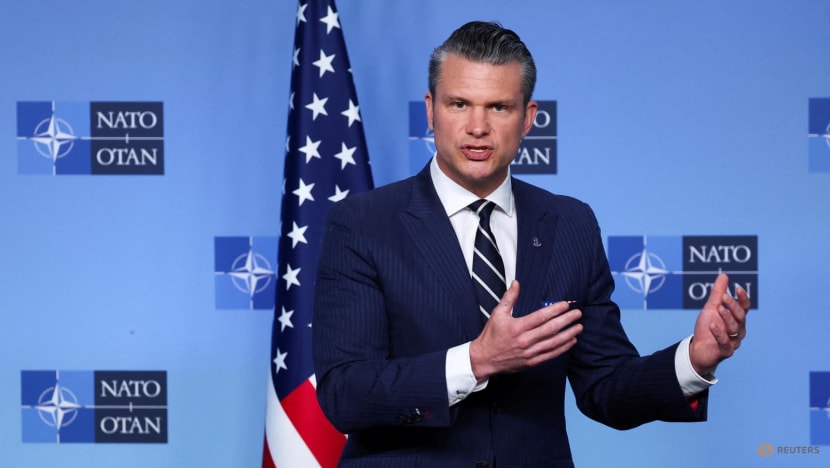Pentagon chief confident NATO will commit to Trump's defence spending target

US Defense Secretary Pete Hegseth speaks to the media on the day of a meeting of NATO Defence Ministers at the Alliance headquarters in Brussels, Belgium Jun 5, 2025. (Photo: REUTERS/Yves Herman)
BRUSSELS: US Defense Secretary Pete Hegseth said on Thursday (Jun 5) he was confident that members of the NATO alliance would sign up to Donald Trump's demand for a major boost in defence spending, adding that it had to happen by a summit later in June.
The US president has said NATO allies should boost investment in defence to 5 per cent of gross domestic product, up from the current target of 2 per cent.
"To be an alliance, you got to be more than flags. You got to be formations. You got to be more than conferences," Hegseth said as he arrived at a gathering of NATO defence ministers in Brussels.
"We're here to continue the work that President Trump started, which is a commitment to 5% defence spending across this alliance, which we think will happen," Hegseth said, adding: "It has to happen by the summit at The Hague later this month."
Diplomats have said European allies understand that hiking defence expenditure is the price of ensuring a continued US commitment to the continent's security and that keeping the US on board means allowing Trump to be able to declare a win on his 5 per cent demand during the summit, scheduled for Jun 24 to 25.
"That will be a considerable extra investment," NATO Secretary-General Mark Rutte told reporters, predicting that in the Hague summit "we will decide on a much higher spending target for all the nations in NATO".
In a bid to meet Trump's 5 per cent goal, Rutte has proposed alliance members boost defence spending to 3.5 per cent of GDP and commit a further 1.5 per cent to broader security-related spending, Reuters has reported.
Details of the new investment plan will likely continue to be negotiated until the eve of the NATO summit.
CAPABILITY TARGETS
In the meantime, Rutte said he expects allies to agree on Thursday on what he called "historic" new capability targets.
The targets, which define how many troops and weapons and how much ammunition a country needs to provide to NATO, would aim to better balance defence contributions between Europe, Canada, and the United States and "make NATO a stronger, fairer and a more lethal alliance", he said in opening remarks to the meeting.
Germany will need around 50,000 to 60,000 additional active troops under the new NATO targets, German Defence Minister Boris Pistorius said as he arrived at the NATO meeting.
Countries remain divided over the timeline for new pledges.
Rutte has proposed reaching the 5 per cent defence target by 2032 – a date that some eastern European states consider too distant but which some others see as too early, given current spending and industrial production levels.
Estonian Defence Minister Hanno Pevkur said that to meet the capability targets, "we need to agree on the 5 per cent in five years. We don't have time for 10 years, we don't have time even for seven years".
Sweden would also like to see NATO reach 5 per cent defence spending in 2030, Defence Minister Pal Jonson told reporters.
There is an ongoing debate over how to define "defence-related" spending, which might include spending on cybersecurity and certain types of infrastructure.
"The aim is to find a definition that is precise enough to cover only real security-related investments, and at the same time broad enough to allow for national specifics," said one NATO diplomat.













